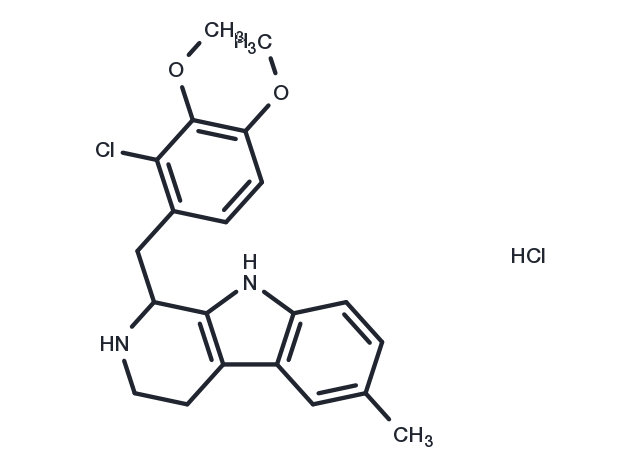Powder: -20°C for 3 years | In solvent: -80°C for 1 year


LY266097 hydrochloride (LY 266097 hydrochloride) is an antagonist of 5-HT2 with pKis of 7.7, 9.8, and 7.6 for human 5-HT2A, 5-HT2B, and 5-HT2C and can be used in studies about depression.

| Pack Size | Availability | Price/USD | Quantity |
|---|---|---|---|
| 1 mg | In stock | $ 34.00 | |
| 5 mg | In stock | $ 118.00 | |
| 10 mg | In stock | $ 176.00 | |
| 25 mg | In stock | $ 297.00 | |
| 50 mg | In stock | $ 443.00 | |
| 100 mg | In stock | $ 639.00 | |
| 1 mL * 10 mM (in DMSO) | In stock | $ 139.00 |

| Description | LY266097 hydrochloride (LY 266097 hydrochloride) is an antagonist of 5-HT2 with pKis of 7.7, 9.8, and 7.6 for human 5-HT2A, 5-HT2B, and 5-HT2C and can be used in studies about depression. |
| Targets&IC50 | 5-HT2A receptor:7.7 (pKi), 5-HT2B receptor:9.8 (pKi), 5-HT2C receptor:7.6 (pKi) |
| In vivo | In vivo electrophysiological recordings of ventral tegmental area (VTA) dopamine (DA) neurons, dorsal raphe nucleus (DRN) 5-HT neurons and pyramidal neurons in the medial prefrontal cortex (mPFC), and the hippocampus were conducted in anaesthetized Sprague-Dawley rats after the administration of 5-HT2B receptor ligands alone or in combination with the SSRI escitalopram. An escitalopram-induced decrease in DA, but not 5-HT firing activity, was rescued by 2-day co-administration of the selective 5-HT2B receptor antagonist LY266097. In the mPFC, 14-day escitalopram administration alone had no effect on pyramidal neuron firing and burst activity, whereas, aripiprazole administered alone or in combination with escitalopram for 14 days increased pyramidal neuron firing and burst activity. Likewise, the administration of LY266097 alone or its addition on the last 3 days of a 14-day escitalopram regimen increased pyramidal neuron firing and burst activity[1]. |
| Synonyms | LY 266097 hydrochloride |
| Molecular Weight | 407.33 |
| Formula | C21H24Cl2N2O2 |
| CAS No. | 172895-39-5 |
Powder: -20°C for 3 years | In solvent: -80°C for 1 year
DMSO: 56.2 mg/mL (138.1 mM), Sonication and heating to 60℃ are recommended.
You can also refer to dose conversion for different animals. More
bottom
Please see Inhibitor Handling Instructions for more frequently ask questions. Topics include: how to prepare stock solutions, how to store products, and cautions on cell-based assays & animal experiments, etc.
LY266097 hydrochloride 172895-39-5 GPCR/G Protein Neuroscience 5-HT Receptor LY 266097 Hydrochloride LY-266097 hydrochloride LY 266097 hydrochloride LY-266097 Hydrochloride LY266097 Hydrochloride inhibitor inhibit
